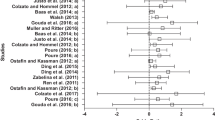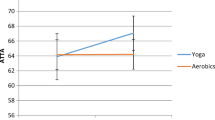Abstract
Scientific interest in meditation has significantly grown in the past years; however, so far, science has neglected the idea that different types of meditations may drive specific cognitive-control states. It has been shown that focused-attention (FA) and open-monitoring (OM) meditation exert specific effect on creativity; OM meditation induces a control state that promotes divergent thinking, a style of thinking that allows many new ideas to be generated, while FA meditation tends to support convergent thinking, the process of generating one possible solution to a particular problem. In the present study, by using creativity tasks tapping into convergent (compound Remote Associates Task; cRAT) and divergent thinking (Alternate Uses Task; AUT), we investigated whether this effect was modulated by prior meditation experience, by comparing a group of practitioners (n = 20) and a group of novices (n = 20). The enhancing effect of OM meditation on divergent thinking was found to be robust irrespective of prior experience. However, while solving convergent-thinking problems, practitioners used an insight strategy, as opposed to an analytical approach, significantly more often than the novices.
Similar content being viewed by others
Change history
13 July 2022
Editor's note: Readers are alerted that concerns have been raised regarding the methodology used in this article. Further editorial action will be taken as appropriate once the investigation into the concerns is complete and all parties have been given an opportunity to respond in full.
References
Akbari Chermahini, S., & Hommel, B. (2010). The (b)link between creativity and dopamine: spontaneous eye blink rates predict and dissociate divergent and convergent thinking. Cognition, 115, 458–465.
Akbari Chermahini, S., & Hommel, B. (2012a). More creative through positive mood? Not everyone! Frontiers in Human Neuroscience, 6, 319.
Akbari Chermahini, S., & Hommel, B. (2012b). Creative mood swings: divergent and convergent thinking affect mood in opposite ways. Psychological Research, 76, 634–640.
Ball, O. E. (1980). The effect of TM and the TM-Sidhi program on verbal and figural creativity (TTCT), auditory creativity (SandI), and hemispheric dominance (SOLAT). Unpublished doctoral dissertation, University of Georgia.
Bowden, E. M., & Jung-Beeman, M. (2003). One hundred forty-four compound remote associate problems: short insight-like problems with one-word solutions. Behavioral Research, Methods, Instruments, and Computers, 35, 634–639.
Bowden, E. M., Jung-Beeman, M., Fleck, J., & Kounios, J. (2005). New approaches to demystifying insight. Trends in Cognitive Sciences, 9, 322–328.
Cahn, B. R., & Polich, J. (2006). Meditation states and traits: EEG, ERP, and neuroimaging studies. Psychological Bulletin, 132(2), 180–211.
Capurso, V., Fabbro, F., & Crescentini, C. (2014). Mindful creativity: the influence of mindfulness meditation on creative thinking. Frontiers in Psychology. doi:10.3389/fpsyg.2013.01020.
Colzato, L. S., Ozturk, A., & Hommel, B. (2012). Meditate to create: the impact of focused-attention and open-monitoring training on convergent and divergent thinking. Frontiers in Psychology, 3, 116.
Colzato, L. S., van den Wildenberg, W. P., & Hommel, B. (2013). Cognitive control and the COMT Val158Met polymorphism: genetic modulation of videogame training and transfer to task-switching efficiency. Psychological Research, 1–9.
Cowger, E. L. (1974). The effects of meditation (zazen) upon selected dimensions of personality development. Dissertation Abstracts International, 34, 8–A, Part 1, 4734.
Csikszentmihalyi, M. (1997). Flow and the psychology of discovery and invention. New York: HarperPerennial.
De Jager, M., & De Jager, J. (2013). Breathfulness: Als weg naar een verruimd leven. Steenbergen: InsideOut. (ISBN 978.908.1194.303).
Domino, G. (1977). Transcendental meditation and creativity: an empirical investigation. Journal of Applied Psychology, 62, 358–362.
Fischer, R., & Hommel, B. (2012). Deep thinking increases task-set shielding and reduces shifting flexibility in dual-task performance. Cognition, 123, 303–307.
Guilford, J. P. (1950). Creativity. American Psychologist, 5, 444–454.
Guilford, J. P. (1967). The nature of human intelligence. New York: McGraw-Hill.
Hommel, B. (2012). Convergent and divergent operations in cognitive search. In M. Todd, T. T. Hills, & T. W. Robbins (Eds.), Cognitive search: evolution, algorithms, and the brain. Strüngmann Forum reports (Vol. 9, pp. 215–230). Cambridge: MIT Press.
Horan, R. (2009). The neuropsychological connection between creativity and meditation. Creativity Research Journal, 21(2–3), 199–222.
Isaacson, W. (2011). iSteve: The book of Jobs. Simon & Schuster (U.S.). (ISBN 1.4516.4853.7).
Jung-Beeman, M., Bowden, E. M., Haberman, J., Frymiare, J. L., Arambel-Liu, S., Greenblatt, R., Reber, P. J., & Kounios, J. (2004). Neural activity observed in people solving verbal problems with insight. Public Library of Science - Biology, 2, 500–510.
Keizer, A. W., Verschoor, M., Verment, R., & Hommel, B. (2010). The effect of gamma enhancing neurofeedback on measures of feature-binding flexibility and intelligence. International Journal of Psychophysiology, 75, 25–32.
Lippelt, D. P., Hommel, B., & Colzato, L. S. (2014). Focused attention, open monitoring and loving kindness meditation: effects on attention, conflict monitoring and creativity. Frontiers in Psychology, 5, 1083. doi:10.3389/fpsyg.2014.01083.
Lutz, A., Slagter, H. A., Dunne, J. D., & Davidson, R. J. (2008). Attention regulation and monitoring in meditation. Trends in Cognitive Sciences, 12(4), 163–169.
Mednick, S. (1962). The associative basis of creative problem solving process. Psychological Review, 69, 200–232.
Nash, J. D., & Newberg, A. (2013). Toward a unifying taxonomy and definition for meditation. Frontiers in Psychology, 4, 806.
Orme-Johnson, D. W., & Granieri, B. (1977). The effects of the age of enlightenment governor training courses on field independence, creativity, intelligence, and behavioral flexibility. In D. W. Orme-Johnson & J. T. Farrow (Eds.), Scientific research on Maharishi’s Transcendental Meditation and TM-Sidhi Program, collected papers (Vol. 1, pp. 713–718). New York: MERU Press.
Orme-Johnson, D. W., Clements, G., Haynes, C. T., & Badaoui, K. (1977). Higher states of consciousness: EEG coherence, creativity, and experiences of the siddhis. In D. W. Orme-Johnson & J. T. Farrow (Eds.), Scientific research on Maharishi’s Transcendental Meditation and TM-Sidhi Program, collected papers (Vol. 1, pp. 705–712). New York: MERU Press.
Raven, J. C. (1965). Advanced progressive matrices set I and II. London: H.K. Lewis.
Russell, J. A., Weis, A., & Mendelsohn, G. A. (1989). Affect grid: a single-item scale of pleasure and arousal. Journal of Personality and Social Psychology, 57, 493–502.
van Steenbergen, H., Band, G. P. H., & Hommel, B. (2010). In the mood for adaptation: how affect regulates conflict-driven control. Psychological Science, 21, 1629–1634.
Wallas, G. (1926). The art of thought. New York: Harcourt Brace.
Acknowledgments
The research of L.S. Colzato is supported by a Vidi grant (#452-12-001) of the Netherlands Organization for Scientific Research (NWO).
Author information
Authors and Affiliations
Corresponding author
Rights and permissions
About this article
Cite this article
Colzato, L.S., Szapora, A., Lippelt, D. et al. Prior Meditation Practice Modulates Performance and Strategy Use in Convergent- and Divergent-Thinking Problems. Mindfulness 8, 10–16 (2017). https://doi.org/10.1007/s12671-014-0352-9
Published:
Issue Date:
DOI: https://doi.org/10.1007/s12671-014-0352-9




